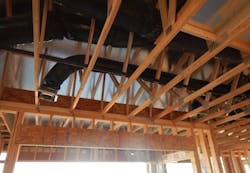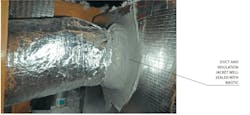Avoid Unnecessary Expense and Homeowner Discomfort: Get HVAC Ducts Right
Do you think the octopus only lives in the ocean depths? Think again. Many attics also house this creature—a splitter box with a tangle of flex ducts that wind their way like tentacles through the truss webs. But while the sea creature is supposed to be intelligent, the attic octopus is less so. Often, it causes homeowner frustration and discomfort while exacting money for the privilege.
Tentacles epitomize the worst defects: loose-laid flex duct with lots of bends and leaky connections. So, it’s important that flexible ducts be properly installed.
If the flex duct isn’t pulled tight, its internal spirals disrupt airflow. The same is true for excessive directional changes. The air handler can be forced to work harder and cycle more than it should in a vain attempt to maintain set point temperature and airflow. That extra stress inevitably reduces the equipment’s service life.
If connections are leaky, the system will be forced to work overtime. A properly sized system needs all air that is designed to flow from each register, so a leak upstream robs rooms of the airflow they were intended to get. And a leaky return can also suck insulation fibers into the airstream, which is a recipe for problems for both the equipment and the occupants.
Also beware of condensation. In winter, air from a leaky return can condense on cold roof sheathing; in summer, air leaking from a supply duct can cool nearby surfaces enough to condense humid attic air. It’s not uncommon for customers to complain about a roof leak when the real problem is condensation that dripped down to the ceiling plane.
RELATED
- Fire Safety: A Guide for Preventing Dryer Vent Fires
- Why Compact Duct Layouts for HVAC Make Sense
- Bring HVAC Ducts Inside
These problems are easy to avoid. For instance, a main trunk with branch ducts will have fewer bends than an octopus—just be sure to pull the flex duct tight and minimize bends. When it comes to joints, traditional duct tape is unacceptable because its rubber-based adhesive eventually dries out and loses its grip. Instead, specify mastic, which doesn’t get brittle over time. Make sure the installer pulls the flex duct’s insulation over the connection, leaving no duct exposed.
While leaky ducts are never acceptable, there is a perception that placing ducts in conditioned space can mitigate some potential risks. But while the leakage may not be leaving the thermal envelope, it is ending up somewhere that it wasn’t intended, such as a floor cavity or chase. Remember that:
• Flex duct sections should be pulled taut between connections. The closer you can space support straps on flex duct the better, otherwise the duct can sag under its own weight, causing the straps to crimp it and restrict airflow.
• On boots, trunk lines, and return boxes, flex duct should be fastened to the connection collar with a nylon draw band and the connection sealed with mastic.
Richard Baker is program manager of the Builder Solutions Team at IBACOS.


